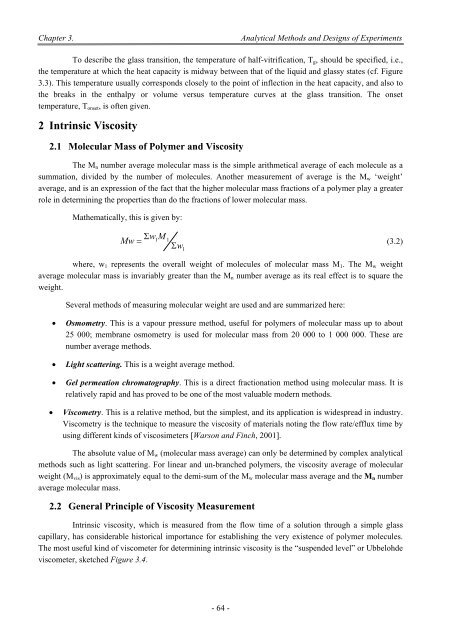Influence of the Processes Parameters on the Properties of The ...
Influence of the Processes Parameters on the Properties of The ...
Influence of the Processes Parameters on the Properties of The ...
You also want an ePaper? Increase the reach of your titles
YUMPU automatically turns print PDFs into web optimized ePapers that Google loves.
Chapter 3.<br />
Analytical Methods and Designs <str<strong>on</strong>g>of</str<strong>on</strong>g> Experiments<br />
To describe <str<strong>on</strong>g>the</str<strong>on</strong>g> glass transiti<strong>on</strong>, <str<strong>on</strong>g>the</str<strong>on</strong>g> temperature <str<strong>on</strong>g>of</str<strong>on</strong>g> half-vitrificati<strong>on</strong>, T g , should be specified, i.e.,<br />
<str<strong>on</strong>g>the</str<strong>on</strong>g> temperature at which <str<strong>on</strong>g>the</str<strong>on</strong>g> heat capacity is midway between that <str<strong>on</strong>g>of</str<strong>on</strong>g> <str<strong>on</strong>g>the</str<strong>on</strong>g> liquid and glassy states (cf. Figure<br />
3.3). This temperature usually corresp<strong>on</strong>ds closely to <str<strong>on</strong>g>the</str<strong>on</strong>g> point <str<strong>on</strong>g>of</str<strong>on</strong>g> inflecti<strong>on</strong> in <str<strong>on</strong>g>the</str<strong>on</strong>g> heat capacity, and also to<br />
<str<strong>on</strong>g>the</str<strong>on</strong>g> breaks in <str<strong>on</strong>g>the</str<strong>on</strong>g> enthalpy or volume versus temperature curves at <str<strong>on</strong>g>the</str<strong>on</strong>g> glass transiti<strong>on</strong>. <strong>The</strong> <strong>on</strong>set<br />
temperature, T <strong>on</strong>set , is <str<strong>on</strong>g>of</str<strong>on</strong>g>ten given.<br />
2 Intrinsic Viscosity<br />
2.1 Molecular Mass <str<strong>on</strong>g>of</str<strong>on</strong>g> Polymer and Viscosity<br />
<strong>The</strong> M n number average molecular mass is <str<strong>on</strong>g>the</str<strong>on</strong>g> simple arithmetical average <str<strong>on</strong>g>of</str<strong>on</strong>g> each molecule as a<br />
summati<strong>on</strong>, divided by <str<strong>on</strong>g>the</str<strong>on</strong>g> number <str<strong>on</strong>g>of</str<strong>on</strong>g> molecules. Ano<str<strong>on</strong>g>the</str<strong>on</strong>g>r measurement <str<strong>on</strong>g>of</str<strong>on</strong>g> average is <str<strong>on</strong>g>the</str<strong>on</strong>g> M w ‘weight’<br />
average, and is an expressi<strong>on</strong> <str<strong>on</strong>g>of</str<strong>on</strong>g> <str<strong>on</strong>g>the</str<strong>on</strong>g> fact that <str<strong>on</strong>g>the</str<strong>on</strong>g> higher molecular mass fracti<strong>on</strong>s <str<strong>on</strong>g>of</str<strong>on</strong>g> a polymer play a greater<br />
role in determining <str<strong>on</strong>g>the</str<strong>on</strong>g> properties than do <str<strong>on</strong>g>the</str<strong>on</strong>g> fracti<strong>on</strong>s <str<strong>on</strong>g>of</str<strong>on</strong>g> lower molecular mass.<br />
Ma<str<strong>on</strong>g>the</str<strong>on</strong>g>matically, this is given by:<br />
Mw<br />
w M<br />
<br />
1 1<br />
(3.2)<br />
w1<br />
where, w 1 represents <str<strong>on</strong>g>the</str<strong>on</strong>g> overall weight <str<strong>on</strong>g>of</str<strong>on</strong>g> molecules <str<strong>on</strong>g>of</str<strong>on</strong>g> molecular mass M 1 . <strong>The</strong> M w weight<br />
average molecular mass is invariably greater than <str<strong>on</strong>g>the</str<strong>on</strong>g> M n number average as its real effect is to square <str<strong>on</strong>g>the</str<strong>on</strong>g><br />
weight.<br />
Several methods <str<strong>on</strong>g>of</str<strong>on</strong>g> measuring molecular weight are used and are summarized here:<br />
<br />
<br />
<br />
<br />
Osmometry. This is a vapour pressure method, useful for polymers <str<strong>on</strong>g>of</str<strong>on</strong>g> molecular mass up to about<br />
25 000; membrane osmometry is used for molecular mass from 20 000 to 1 000 000. <strong>The</strong>se are<br />
number average methods.<br />
Light scattering. This is a weight average method.<br />
Gel permeati<strong>on</strong> chromatography. This is a direct fracti<strong>on</strong>ati<strong>on</strong> method using molecular mass. It is<br />
relatively rapid and has proved to be <strong>on</strong>e <str<strong>on</strong>g>of</str<strong>on</strong>g> <str<strong>on</strong>g>the</str<strong>on</strong>g> most valuable modern methods.<br />
Viscometry. This is a relative method, but <str<strong>on</strong>g>the</str<strong>on</strong>g> simplest, and its applicati<strong>on</strong> is widespread in industry.<br />
Viscometry is <str<strong>on</strong>g>the</str<strong>on</strong>g> technique to measure <str<strong>on</strong>g>the</str<strong>on</strong>g> viscosity <str<strong>on</strong>g>of</str<strong>on</strong>g> materials noting <str<strong>on</strong>g>the</str<strong>on</strong>g> flow rate/efflux time by<br />
using different kinds <str<strong>on</strong>g>of</str<strong>on</strong>g> viscosimeters [Wars<strong>on</strong> and Finch, 2001].<br />
<strong>The</strong> absolute value <str<strong>on</strong>g>of</str<strong>on</strong>g> M w (molecular mass average) can <strong>on</strong>ly be determined by complex analytical<br />
methods such as light scattering. For linear and un-branched polymers, <str<strong>on</strong>g>the</str<strong>on</strong>g> viscosity average <str<strong>on</strong>g>of</str<strong>on</strong>g> molecular<br />
weight (M vis ) is approximately equal to <str<strong>on</strong>g>the</str<strong>on</strong>g> demi-sum <str<strong>on</strong>g>of</str<strong>on</strong>g> <str<strong>on</strong>g>the</str<strong>on</strong>g> M w molecular mass average and <str<strong>on</strong>g>the</str<strong>on</strong>g> M n number<br />
average molecular mass.<br />
2.2 General Principle <str<strong>on</strong>g>of</str<strong>on</strong>g> Viscosity Measurement<br />
Intrinsic viscosity, which is measured from <str<strong>on</strong>g>the</str<strong>on</strong>g> flow time <str<strong>on</strong>g>of</str<strong>on</strong>g> a soluti<strong>on</strong> through a simple glass<br />
capillary, has c<strong>on</strong>siderable historical importance for establishing <str<strong>on</strong>g>the</str<strong>on</strong>g> very existence <str<strong>on</strong>g>of</str<strong>on</strong>g> polymer molecules.<br />
<strong>The</strong> most useful kind <str<strong>on</strong>g>of</str<strong>on</strong>g> viscometer for determining intrinsic viscosity is <str<strong>on</strong>g>the</str<strong>on</strong>g> “suspended level” or Ubbelohde<br />
viscometer, sketched Figure 3.4.<br />
- 64 -

















